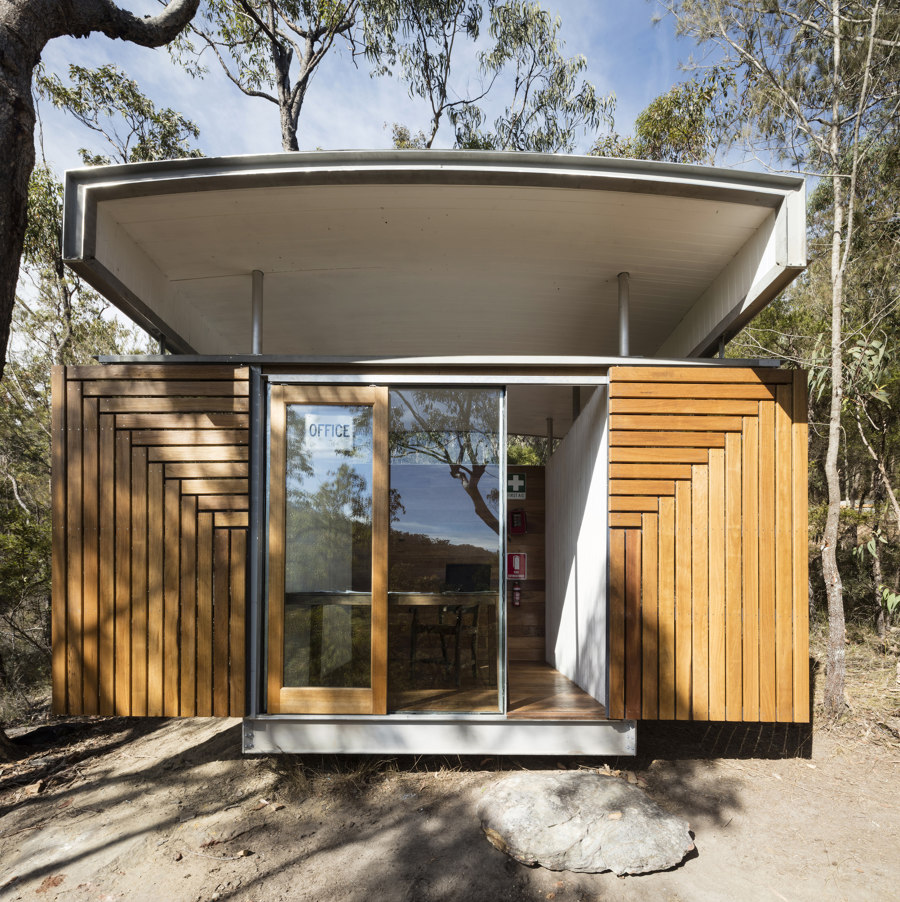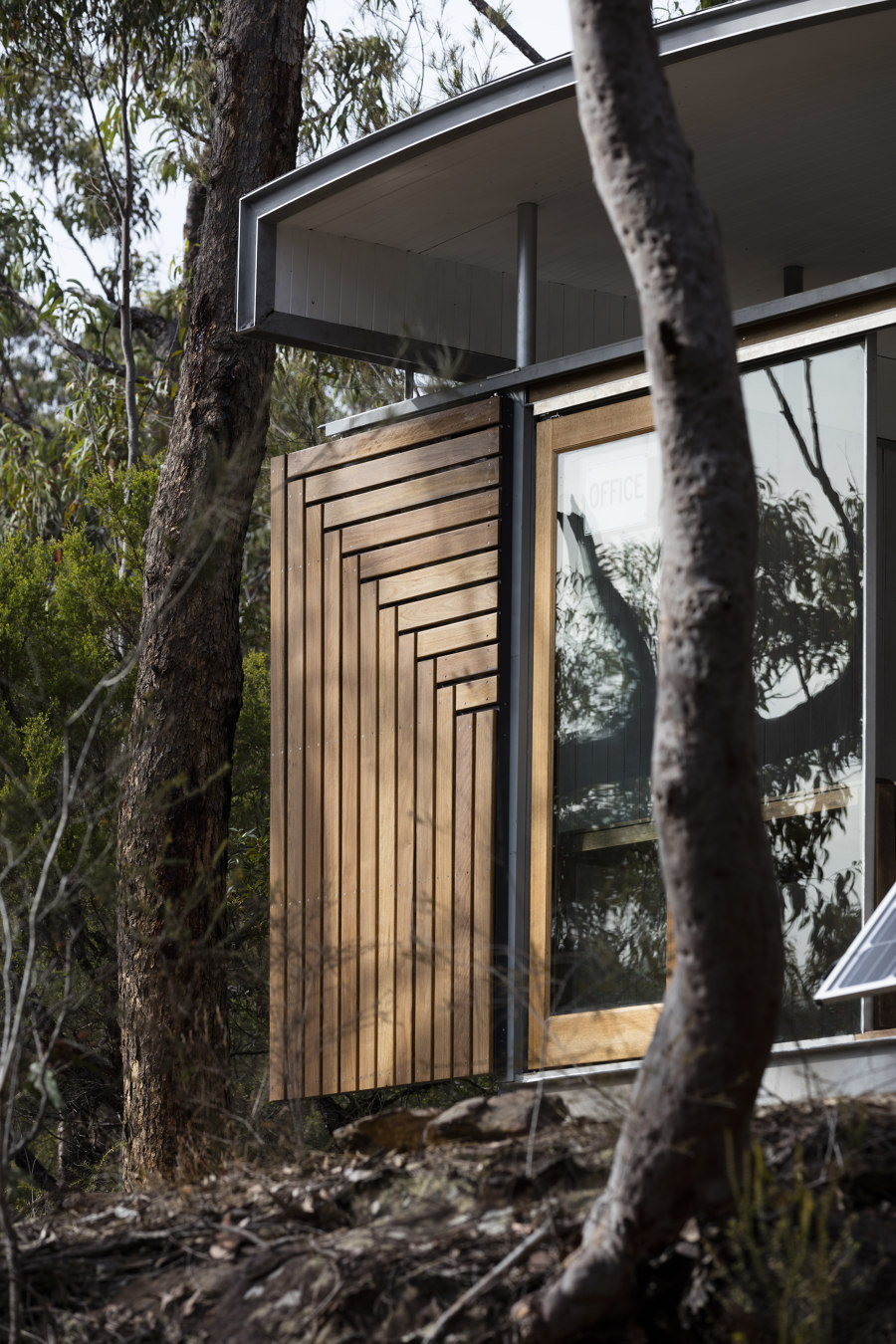Architectural models are often the mainstay of an architect’s design process, but it’s not often that an architect proposes a 1:1 scale architecture model. But that’s what architect builder Scott Flett proposed to his parents, also the clients during the design process for their upcoming house in Tasmania. No stranger to building in remote and off grid locations, Scott offered to build a model prototype of a room and use it as a site office while building another project along the Hawksbury River in NSW for Ecoshelta, a prefabricated building company based in Sydney.
“I’m not exactly the first son to build a house for their folks, but so far, they’ve been the best clients I’ve ever had…which might be a first’’ says Scott. “They were patient enough to let me make a prototype in my down time and thankfully they liked the result. Mum likes the timber screens and Dad’s pretty impressed with my welding… and that my education has apparently not been wasted.”
In many ways, this prototype harks back to Scott’s university days making models, scavenging materials from recycle bins and thrift shops, but this time reusing materials left over from previous builds. The timber screens are recycled tallow wood left over from a large deck installation – where the striking pattern facilitates using timber off-cuts, the front door a manufacture reject from a studio in the NSW Royal National Park, the floor boards salvaged from a terrace in Stanmore, stud walls reconditioned from a church in Newtown, the pine ceiling from a holiday house in the Central Coast, even the desk and chair was a hard rubbish collection find. “It’s definitely been nice to give these materials another story that doesn’t include the rubbish tip, and then weld the rest together” says Scott.
While it’s the use of timber that immediately draws your attention, there’s a prefabricated metal structure underneath that is equally inventive. The office is a collection of 45 marine grade structural aluminium alloy members, most of which are hidden. The structure was prefabricated in Sydney, flat packed on the tray of a ute, carried to site and bolted together. “I usually describe the alloy structure as being several grades below a space rocket, a few grades below a QANTAS jet, on par with Sydney’s newest Ferry and several grades above the smart phone in your pocket” explains Scott. And while the use here might at first appear over the top, as soon as you step on site the choice seems surprisingly natural; there is only partial road access and a steep craggy escapement down to site. Strength and lightness are invaluable in such terrain. It makes one recall that this is the same landscape that produced the kangaroo, whom are literally at home in this area. With a tiny 1.2m x 1.2m structural footprint, this site office bolts on to the sandstone and cantilevers over the nearby bush in a location that would otherwise be almost unbuildable.
It was also a process that the architect clearly took delight in: “it’s many a bloke fantasy to build themselves the ultimate man cave, and I like to think of this as less of a site office, and more of the ultimate back yard shed. Just that I’ve been taking my shed with me to work. It stores my tools, gives me a place to draw, tinker, try things out, gives me a place to stuff up without anyone noticing and start again. The whole shed is a work in process, reminders of what did and didn’t work, it’s a working 1:1 architectural model. It has also been a lovely office to work in and I would take this over an office in Manhattan any day”. While I’m sure Scott’s parents would be somewhat concerned their future house is not a larger version of an ‘’ultimate man cave’’, if it’s a sum of these many parts, you can understand why they eagerly anticipate his return.
Submission to Awards:
Small Project Submission. Welcome to my (site) office.! At 5.76m2 this off grid site office is the epitome of small project architecture with big aspirations. This project is a working prototype of my growing portfolio of residential work that lead Green Magazine to identify SFAW as a leading Australian architecture firm in prefabricated building. In the words of Green Magazine editor Georgia Thomas: “We’ve rounded up six of the best projects that prove just how versatile and sustainable prefab can be.” This project is a combination of the Tasmanian ‘architect-maker’ pedagogy and one of the most traditional of architectural design processes: model making. Architectural models are often the mainstay of an architect’s design process, and I built this site office like most architects make models, the only difference being scale. Even the making of this project harks back to model making at university, scavenging materials from recycle bins and thrift shops. Except this time reusing materials left over from previous builds; the timber screens are recycled tallow wood left over from a large deck installation – where the striking pattern facilitates using timber off-cuts, the front door a manufacture reject from a studio in the NSW Royal National Park, the floor boards salvaged from a terrace in Stanmore, stud walls reconditioned from a church in Newtown, the pine ceiling from a holiday house in the Central Coast, even the desk and chair was a hard rubbish collection find. While it’s the use of timber that immediately draws your attention, there’s a prefabricated metal structure underneath that is equally inventive. The office is a collection of 45 marine grade structural aluminium alloy members, most of which are hidden. This is an innovative approach that borrows heavily from the current Tasmanian boat building technologies within Australia’s advance manufacturing industry. The structure was flat packed on the tray of a ute, carried to site and bolted together. I usually describe the alloy structure as being several grades below a SpaceX rocket, a few grades below a QANTAS jet, on par with Sydney’s newest Ferry (made in TAS) and several grades above the smart phone in your pocket. The benefits of such a technological adoption are evident on a site without road access. The light weight structure can be comfortably carried to location by hand without disturbing the landscape. Besides being published in Green magazine, this project has been widely published over social media including a special feature on The Local Project, but also on the Australian Architecture & Bluescope Steel Instagram pages. This site office did not start out at a presentation model, but it has since become a catalyst for my current emerging body of work.
Design Team:
Flett Architecture: Scott Flett























